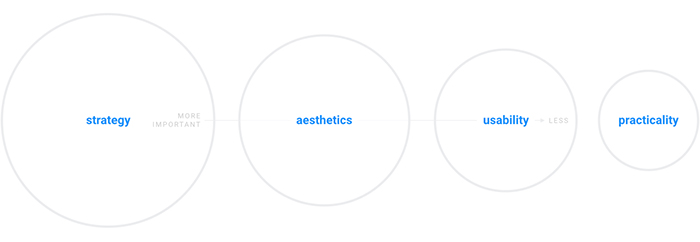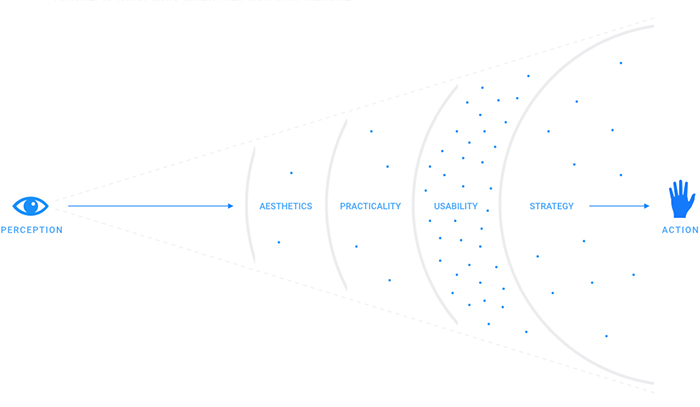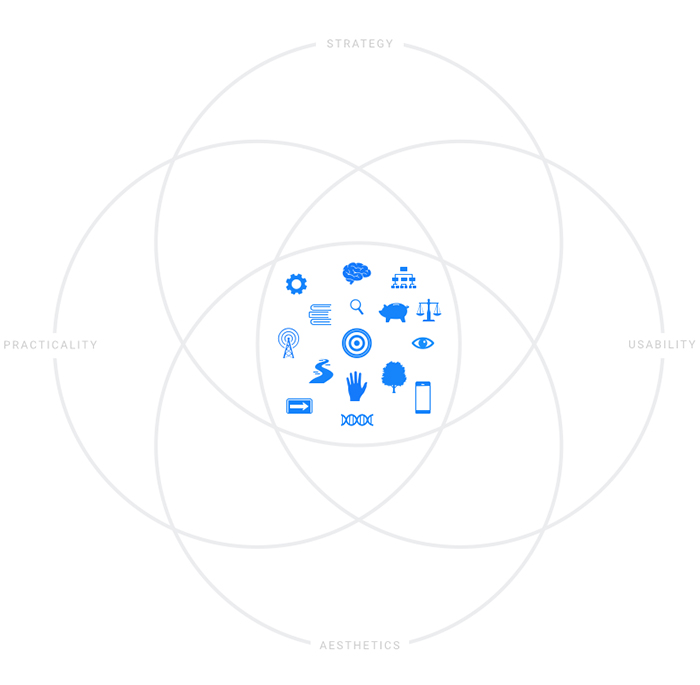A common misunderstanding about effective marketing is that it works against good design — that the proven tactics of marketing impose a utilitarian, function-over-form ethic on all marketing systems and work, forcing teams that otherwise value good design to set aside their aesthetic sensibilities especially when creating their website.
Nothing could be further from the case!
In fact, good marketing needs good design. This is because good design isn’t just about beauty, inspiration, or even seduction. Good design is simply about giving the right form to intent. And marketing, of course, is all about intent.
In this white paper, you’ll learn the basic building blocks of good, digital marketing focused website design. We call this method Prospect Experience Design (PX), and as you’ll soon discover, its 16 individual, measurable components describe an elegantly ordered system of design that will enable the best results — new, qualified opportunity for your firm — while also facilitating the greatest freedom to express your expertise and brand visually.
Redefining Good Design for Marketing Websites
Design for marketing has its greatest impact on your website. But, your website is more than just a thing of beauty. Its purpose is to work for you — to have a measurable impact on your business.
You can make sure that happens by adopting a permanent system of design accountability to keep your goals and activity in sync.
When thinking about your website, it’s helpful to organize your thoughts into four categories: Strategy, Aesthetics, Usability, and Practicality.

Each category provides a different perspective on your goals and the actions you can take to achieve them. They will help you answer questions like what your website should do, how it should work, what it should look like, and how it should be created. (They’ll also make up the foundational structure of a repeatable design method. That’s where Prospect Experience Design (PX) comes in, but more on that in a moment.)
Aesthetics actually bridge the gap between your goals and the actions you take to achieve them because visual choices affect how a brand is perceived as well as how information is communicated. So again, you can rest assured that not just design, but aesthetics, too, play an essential role in digital marketing.
But more importantly, each of these categories provides a unique perspective on digital marketing by describing common elements to work on and then by prioritizing them for you.

And yes, that means that some elements are more important than others.
For example, without certain strategic elements, your website will lack the ability to create new opportunity.
But with the right strategic elements, even a poor user experience won’t be enough to prevent your website from having some measurable marketing impact.
Every element across these four categories will have an impact on how your website is discovered, understood, and used.

Imagine that each category is a layer through which your prospects must work when they visit your website.
Before they can take the actions you want them to take, they first need to make their way through the aesthetic and technical choices you have made.
The Elements of Good Design for Digital Marketing
Among the four categories are 16 unique, measurable elements. Each one will either make this process easier or more difficult for your prospects.
Strategy
The strategic elements are the governing principles of your website, and of the design you create for it. Each one is essential to achieving its purpose, and relies upon the others to play its part. A good message requires the right structure to be read and understood by the right people at the right time; effective insight must attract the right audience and set them up to understand your purpose as a business and how you structure the work you can do for them; engagement must be synchronized with a prospect’s needs, the content with which it’s associated, and the structure of your business; and so on.
The strategic elements of a website are its:
- Message
Is what you do clearly articulated on every page of your website? - Structure
Do your pages intentionally guide prospects toward taking the actions you want them to take? - Insight
Does your website contain a robust and growing repository of content that attracts, informs, and engages the right prospects? - Engagement
Is your website supported by a diversity of smart calls to action that progressively gather, score, and categorize prospect data within CRM and marketing automation systems?
Aesthetics
The demands of digital marketing on design are strategic in nature and structural in implication, but aesthetically neutral.
In this context, aesthetics have nothing to do with what you find beautiful versus what I or a prospect finds beautiful. Instead, the aesthetic elements of your website can be understood as the way you use visual information. As is true with every one of the sixteen elements reviewed here, every organization and every designer has a prerogative of sensibility, and rather than thinking of it as answering to the structure these elements comprise, it’s better thought of as facilitated by them.
In other words, I often think of our job as helping organizations share the truest expression of their expertise. Their taste — their sensibilities and preferences that shape their visual language — are essential to doing that well, and are always more effective and coherent when the structure beneath them is strategically sound.
The aesthetic elements of a website are its:
- Signal-to-Noise Ratio
Is content prioritized in your design, or have you paid more attention to decorating the container? - Visual Complexity
Does your design place a minimal cognitive burden on prospects by keeping the visual information it presents to a minimum?
Usability
The elements often brought to mind by words like “design” are, ironically, things I often talk about quite infrequently unless they are mishandled and get in the way of a website’s usability. This is why I organize them as elements of usability rather than the core components of a website’s design.
As I mentioned earlier, every designer’s prerogative of sensibility should be facilitated by recommendations that are strategic in nature and structural in implication. That means that a designer should be free to use any typeface, so long as it doesn’t make it more difficult for a prospect to understand the message of you website and take the actions you need them to take. This is true of every element within your visual language — colors, textures, imagery, and the like.
Aside from typography, however, the elements that have the greatest impact on a website’s usability are:
- Typography
Is content easy to read? - Navigation
Are menus simple to access and use? - Visual Language
Are your design patterns consistent? - Accessibility
Does the website work in a variety of contexts and with a variety of devices? - Search
Can your prospects find what they’re looking for? - Focus
Are your pages free of internal distractions?
Practicality
Finally, practical elements are those that will impact the process of creating and using a website. Once design decisions have been vetted by strategic purposes, aesthetic properties, and their usability, they need to be considered practically as well.
The practical elements that have the greatest impact on the process of creating and nurturing a website are:
- Resources
Are you able to implement within a reasonable timeline and at an affordable price? - Strategic Weight
Is your design proportionately scoped to prefer strategic and measurable attributes over creative expression? - Stability
Is your design dependent upon techniques that will compromise the consistent performance, accessibility, or maintenance of your website? - Scalability
Is your design scalable and sustainable by the administrator and/or content creators who will inherit it?
Understanding and treating these elements properly is essential to creating an effective marketing website.
You can use this structure to govern your initial design process, as well as to nurture it properly afterward. It will ensure that you never lose sight of your original strategic objectives.

This is Prospect Experience Design (PX)
Prospect Experience Design (PX) is the discipline of making it easy for prospects to do what you want them to do.
These concepts support an approach to design for marketing websites called Prospect Experience Design (PX).
Prospect Experience Design (PX) can be best summarized in contrast to a basic definition of User Experience Design (UX).
UX is the discipline of making it easy for users to do what they want to do. Design for the web and the complex array of interactions that occur there needs this. That is because the web isn’t simply a presentation of information. It’s an environment in which information can be created, exchanged, and acted upon.
Marketing is a sub-set of that activity, and it requires its own unique variation upon the theme of intentional interaction design. Marketing has a smaller audience than the web at large, a smaller set of objectives, and a much smaller set of specific actions it expects. That’s where PX comes in.
Prospect Experience Design (PX) is the discipline of making it easy for prospects to take those specific actions — to do what you want them to do.
The purpose of marketing is to create opportunity. There is no effectiveness to doing marketing without understanding Prospect Experience Design.
Measuring Your PX
At the beginning of this white paper, I mentioned (and emphasized) how these elements are measurable. A system like this is only as useful as it is measurable.
Every client that goes through our Digital Marketing Program first experiences a rigorous Prospect Experience Design Audit of their website, which organizes every measurable element of this system, calculates and visualizes simple scores, and produces recommendations for improving areas of weakness. The audit can be run at any point to track the effectiveness of your design system as it evolves.
If you’re interested in learning more about how that works, you can read more about the PX Audit here.